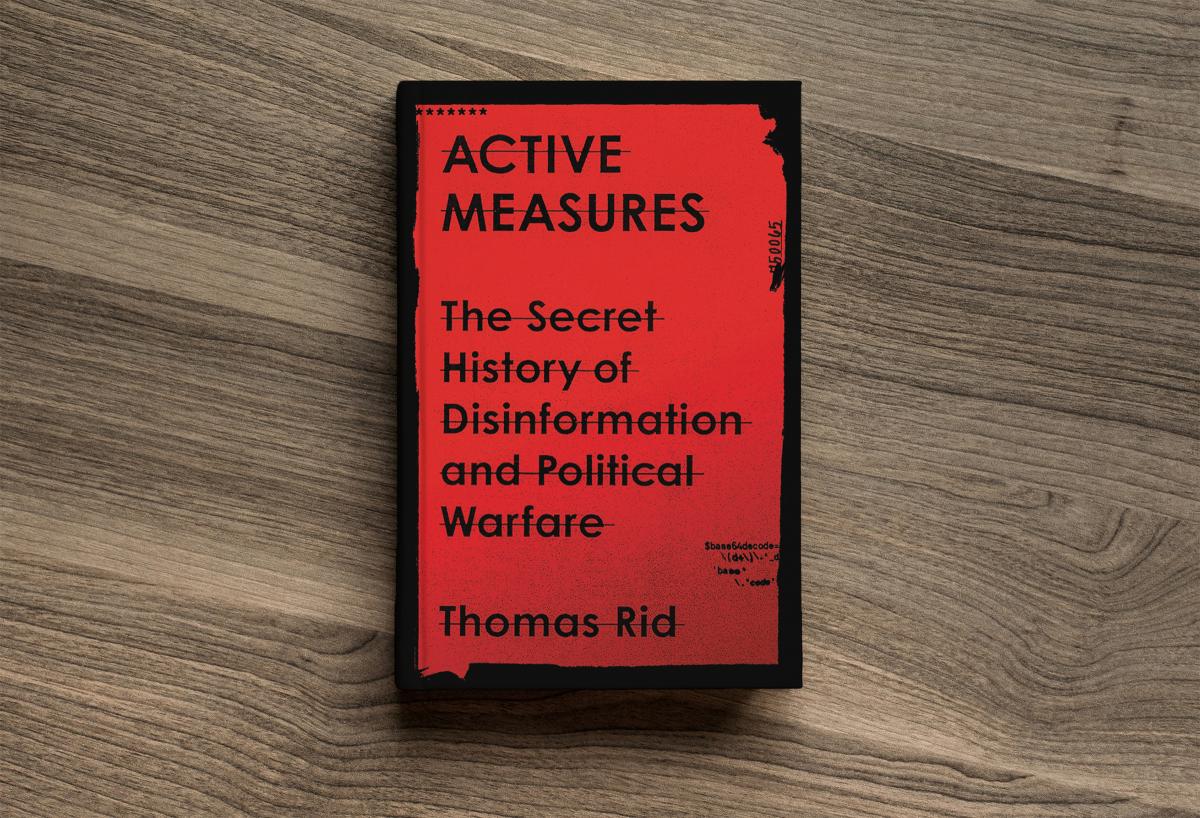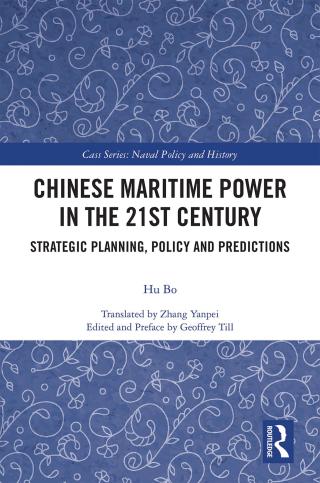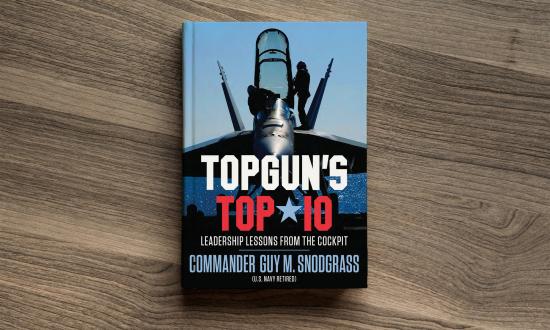Active Measures: The Secret History of Disinformation and Political Warfare
Thomas Rid. New York: Farrar, Straus and Giroux, 2020. 513 pp. Photos. $30.
Reviewed by John Prados
The questions of what disinformation is and how it fits into political warfare have been thrown into high relief by the apparent Russian intervention in the U.S. elections of 2016 and 2020. Here, Thomas Rid (Rise of the Machines: A Cybernetic History, W. W. Norton & Company, 2016), who testified before the Senate Select Committee on Intelligence about the Russian gambit, ranges back over a century to fashion a detailed look at the technique, tactics, and practice of disinformation.
Rid argues that the history of disinformation began in the 1920s (I wonder how he would deal with the Zimmerman Telegram), with the Soviet conspiracy built around “The Trust,” then had a succession of waves—becoming professionalized after World War II, finely tuned and resourced in the 1970s, and reshaped by technology in the 2010s. Today, the age is pervaded by disinformation and requires us to be able to recognize “active measures,” a term for misinformation coined by Russian practitioners. So pervasive has the practice become, Rid warns, that the tactic is
actually disintegrating (harder to control, contain, steer, manage, or assess). Unlike truth in its classic sense, now “truth . . . is relative to a specific community with shared values, and thus inherently political.” This makes disinformation possible.
The narrative that supports this analysis consists of a series of inquiries into operations such as The Trust, in which the Soviets created a fake anti-communist resistance to entrap potential enemies of the state. In the 1920s, according to a Russian intelligence history Rid makes great use of, the Soviets concocted an alleged plan for Japanese aggression that submerged—and reemerged—numerous times until Pearl Harbor. Here is another theme of Active Measures. Elements of deception require points of (real) truth to be credible, but once laid down, can be mixed and matched into the future for new tries at the prize. Swirling ephemera and situational facts provide new opportunities for given ploys, exactly like those used to intervene in U.S. politics in 2016—and now in 2020. New information can recontextualize the old saw.
Rid loses a bit of focus as he moves through time. The CIA operations in Berlin that he covers as disinformation have more in common with political action—even seeding the East with leaflets and smuggling literature, in my view, are about propaganda, related to active measures but not the same thing. This is the “political warfare” of the book’s title. There is a tension here between disinformation and political warfare that is never really resolved. The forgeries and hacking of, say, the 1960s and 1970s, and 2016, are granular items in a big-picture campaign of political warfare, but we are missing the big picture.
It was probably irresistible to cover the CIA ops, since there now are a host of available authentic documents, and there lies a different rub. Rid is good on the modern period, where he has singular evidence on cyber attacks; on the CIA operations, where he has documents; and on the Russian and Eastern Bloc disinformation schemes, for which he has witnesses and Russian histories. But for periods such as the 1980s, when active measures were a talking point for U.S. propaganda, the evidence shrinks to the same congressional hearings and agency talking points that were waved around at the time. The KGB was an active participant in political warfare, but it is a fallacy to attribute controversies over the neutron bomb, the nuclear freeze, and nuclear winter solely to Soviet active measures. The KGB helped stoke controversies that were already smoldering.
This is a useful book, and it advances the scrimmage line, but the goalpost is still downfield.
John Prados is a senior fellow at the National Security Archive in Washington, DC. His most recent book is The Ghosts of Langley: Into the CIA’s Heart of Darkness (New Press, 2017).
Chinese Maritime Power in the 21st Century: Strategic Planning, Policy and Predictions
Hu Bo. Translated by Zhang Yanpei. Edited and preface by Geoffrey Till. New York: Routledge, 2020. 273 pp. Notes. Maps. Index. $160.
Reviewed by Captain Sam J. Tangredi, U.S. Navy (Retired)
China watchers suggest that Hu Bo is perhaps the most important civilian naval strategist in the People’s Republic of China. He certainly is one of the most prolific, although Chinese Maritime Power in the 21st Century is his first book-length work to be translated into English. Hu is research professor at the Institute for Ocean Research at Peking University and director of its Centre for Maritime Strategy Research. Whether he has any influence over the Chinese Communist Party’s maritime policies or on the thinking of the People’s Liberation Army Navy (PLAN) leaders is impossible to tell. In 2019, he paid a visit to the U.S. Naval War College, hosted by its China Maritime Studies Institute, so certainly the regime trusts him to present a positive picture of Chinese naval developments.
And that he does in this book, but his approach is in scholarly language and appears more thoughtful than any direct propaganda. In deference to the policy of downplaying PLAN capabilities, Hu uses the technique of the Soviet naval writers of the Cold War: address concepts and capabilities in terms of U.S. naval forces, and sometimes the Royal Navy, not the PLAN. In fact, when he does discuss the capabilities of China’s DF-21D missile—the so-called carrier killer—he cites reports from the U.S. Department of Defense, not any Chinese source. He routinely discusses the writings of American naval analysts, but rarely Chinese. Thus, he can describe the global naval strategy of the United States—which clearly he wants (and expects) China to adopt—without revealing official Chinese policy or suggesting that a professor is attempting to dictate to the Party.
To say Hu is a Mahanian is an understatement. In his view, it is necessary for the PLAN to “step out” (his term) beyond the first and second island chains, which were protective barriers useful in the past. He readily concedes as a point of logic that the geography and geopolitical interests of the United States should (I must emphasize should) lead it to devote more financial resources to the U.S. Navy than China does to the PLAN. As part of the Eurasian heartland, China needs to devote the majority of its attention to land power. Nevertheless, Hu’s recommendation and prediction (as per the title) are clear: “In other global maritime regions [beyond the Pacific], Chinese power needs to exert more important influence. This is a necessary requirement in order to protect overseas interests and fulfill the responsibilities of a global power.”
Concerning the disputes in the South China Sea, Hu is decidedly unapologetic and brooks no alternative explanations. In South China Sea disputes, China clearly is the aggrieved party, harassed by nations trying to “profit from trouble.” “Coerced by the situation, China has no choice but to begin asserting its rights,” he writes. In fact, one of the justifications Hu uses to account for China’s construction of artificial islands on the reefs in the South China Sea (sorry, “land reclamation”) is “to ‘teach Vietnam and the Philippines a lesson’ to quell their hubris.” What other nations, particularly the United States, apparently do not understand is that “sovereignty, security, political and economic interests means that China must gain a strategic advantage in the seas of East Asia, which can be regarded as the strategic bottom line of China’s maritime power.”
As concerns the global naval competition between the United States and China, Hu maintains there is no problem with the PLAN being the “world’s number two navy”—as long as it is roughly comparable in power to the U.S. Navy and decidedly number one in the western Pacific. As always with its statements, China does not intend to be the naval hegemon. If the United States goes so far as to neglect its Navy and the PLAN becomes number one, well, that is the United States’ problem, isn’t it?
What should readers make of the book? Is it a semiofficial statement of what the Chinese Communist Party intends, the musings of a Mahan-obsessed navalist, or needed for a professor’s promotion? Based on continuing developments, I would argue that it is a semiofficial statement of what the Party intends. In fact, perhaps Hu can be invited to contribute to the next edition of the U.S. Department of Defense’s Annual Report to Congress on Military and Security Developments Involving the People’s Republic of China. Nothing he could add would be any less alarming.
Captain Tangredi is the Leidos Chair of Future Warfare Studies at the U.S. Naval War College. He is a frequent contributor to Proceedings.
Battlegrounds: The Fight to Defend the Free World
Lieutenant General H. R. McMaster, U.S. Army (Retired). New York: Harper, 2020. Photos. $35.
Reviewed by Steve Cohen
Lieutenant General H. R. McMaster’s new book may not be the story that half the country wanted, but it is the book all of us need. Battlegrounds: The Fight to Defend the Free World is not a tabloid tell-all. It is a sober, thoughtful, intelligent volume that deserves shelf space for anyone serious about U.S.
foreign policy in the first part of the 21st century.
General McMaster served 34 years on active duty in the Army, the last two as President Donald Trump’s second national security advisor—until he was fired in March 2018, the same month the President fired Secretary of State Rex Tillerson. However justified McMaster may have been in extracting a bit of revenge for his shabby treatment by the President, he assiduously avoids ad hominem attack territory. Instead, he devotes more than 500 pages to seven parts of the world that commanded his attention, both during his 12 months as national security advisor and during his career as a military professional.
Battlegrounds is more a think-tank treatise than a compelling narrative. I found myself reading different parts based on my mood driven by the morning’s news headlines. General McMaster himself illuminates each of the book’s seven parts with full page of bold or italic headlines that telegraph the primary media takes on each region he covers. For example, the Iran section begins with, “TEHRAN STUDENTS SEIZE U.S. EMBASSY AND HOLD HOSTAGES” and ends with “Clerics get lost!” (Mr. Trump’s ubiquitous tweets are interspersed with news headlines.) By focusing on a single geographic area in each section, and then pausing to digest General McMaster’s stories and insights, the full value of his perspective becomes apparent.
What truly shocked me was who was left out of the book. There is not a single mention of Defense Secretary James Mattis, even though their tenures completely overlapped. Secretary of State Tillerson gets just two brief mentions, and U.N. Ambassador Nikki Haley exactly one. It led me to wonder what else a national security advisor, writing a history of an administration’s foreign policy, omitted.
Nonetheless, the book is rich in detail. For example, General McMaster writes that Secretary of State Tillerson was about to issue a letter under the terms of the Iran Nuclear Agreement Review Act (INARA), stating that Iran was in compliance with the terms of the Joint Comprehensive Plan of Action nuclear deal. But Tillerson’s first letter was never issued, as McMaster “knew the President would be incensed” at such a position.
Instead, following a meeting with McMaster and the President, Tillerson released a revised letter stating that the nuclear deal “fails to achieve the objective of a non-nuclear Iran.” He added that the Iran deal “represents the same failed approach of the past that brought us to the current imminent threat that we face from North Korea.” Oh, to have been a fly on the wall during that discussion.
I met H. R. McMaster in 2002 at a conference (on the future of the service academies) sponsored by the U.S. Naval Institute and the McCormick Tribune Foundation. Afterward, I purchased his book, Dereliction of Duty, an adaptation of his PhD thesis on failed communications and flawed decision-making during the Vietnam War. As I was finishing this review of Battlegrounds, I picked up my dog-eared, heavily annotated copy of Dereliction. As I skimmed its pages, I realized how relevant that earlier volume was to General McMaster’s later service and how Battlegrounds will probably stand the test of time as well.
Mr. Cohen is an attorney at Pollock Cohen LLP in New York and a former member of the U.S. Naval Institute Board of Directors.
Adaptation Under Fire: How Militaries Change in Wartime
Lieutenant General David Barno, U.S. Army (Retired), and Nora Bensahel. Oxford, UK: Oxford University Press, 2020. 407 pp. Biblio. Index. $34.95.
Reviewed by Captain Joshua Himes, U.S. Navy
Retired Lieutenant General David Barno and Nora Bensahel have combined efforts to address the U.S. military’s critical need to improve adaptability if it is to be successful in future conflicts. They set the stage early, leveraging the classic reference by former Defense Secretary Robert Gates concerning the inability of the United States to predict the next war—“We have never once gotten it right” to enforce the importance of successful adaptation for unexpected circumstances and conflicts.
Barno and Bensahel make a compelling case that, although adaptation has always been relevant, the nexus of strategic uncertainty; exponential change in technology, connectivity, urbanization, and globalization; and the complexity of rising conventional threats makes the future environment uniquely unpredictable and threatens the ability of the U.S. military to prevail in 21st-century conflict.
The book frames adaptation through the lens of doctrine, technology, and leadership. The authors argue that these three components are essential to military adaptability and that militaries with the most adaptable doctrine, technology, and leadership have a critical and perhaps decisive advantage in wartime. I appreciated that they were willing to cite leadership as the first among equals in the framework, which is certain to catalyze spirited debate among War College students for years to come.
After several in-depth, largely academic chapters informed by historical vignettes that define and unpack adaptation and the component terms, the authors use a doctrine, technology, and leadership lens to examine U.S. warfare success and failure in Iraq and Afghanistan. This section is the heart of the book and provides useful context to further evaluate whether the U.S. military is sufficiently adaptable to face an uncertain and lethal threat environment.
This book focuses almost exclusively on land warfare vignettes as evidenced by counterinsurgency (COIN) doctrine in Iraq, and the Provincial Reconstruction Team, and civil-military evolution in Afghanistan as primary topics. Perhaps the most interesting elements focus on leadership adaptation examples, juxtaposing tactical leadership success stories. For example, then-Colonel Sean MacFarland’s unorthodox but effective COIN approach in Anbar Province and Ramadi in 2006–07 and Captain Mark Nutsch’s Horse Soldiers of the 5th Special Forces Operational Detachment Alpha (ODA) 595 in the early days after 9-11 against the Taliban, against the theater leadership stories of General George Casey in Iraq and General Dave McKiernan in Afghanistan. Both show a failure to fully understand and adapt to deteriorating conditions in their respective areas of operation.
The authors make a compelling case that adaptation is more critical now than ever. The strategic uncertainty (near-peer threats, gray zone warfare, and unpredictable regional actors), the untested domains of space and cyber, and the unrelenting pace and scale of change reflected in the Fourth Industrial Revolution all converge to present a most daunting environment for the U.S. military in the future. The book culminates by addressing future adaptability risk areas, including acquisition, military education, and leaders’ risk aversion, to highlight just a few that likely will resonate with readers.
The final chapter provides recommendations to improve adaptability and mitigate risk of failure. These include adding adaptability as a tenth principle of war, addressing institutional shortfalls in technology integration, and putting greater emphasis on mission command.
More broadly, this study provides a valuable addition to collective insight on military warfare and is certain to be part of future reading lists, as well as great material for War College discussions. The author’s hope is that this book will excite a “long-overdue conversation” on ensuring the military becomes more adaptable. In an era when an increasingly dated National Defense Strategy seems to limit critical thinking on future threat environments, the timing of this work is impeccable.
Captain Himes is the commander of the Joint Intelligence Center, U.S. Central Command.
The New Rules of War: How America Can Win Against Russia, China and Other Threats
Sean McFate. New York: HarperCollins, 2020. 336 pp. Notes. Biblio. Index. $29.99.
Reviewed by Commander David A. Buzard, JAGC, U.S. Navy Reserve (Ret.)
With Admiral James Stavridis praising its author as “a new Sun Tzu,” and the Army War College having added it to its reading program, it seems that The New Rules of War by Sean McFate has become essential reading. And a must-read it is, both for lay devotees of military affairs and serious security-sector professionals. To the former, enthralled by the might of U.S. arms during the 20th century, it is a clarion call for fundamental change in strategic and tactical thinking. To the latter, it is nothing new: “We’re already behind in adapting to the changed character of war today in so many ways,” declared Chairman of the Joint Chiefs of Staff Marine Corps General Joseph Dunford to the 2016 graduating class at the National Defense University, on whose faculty McFate sits.
McFate relays the message in riveting Tom Clancy style sure to please the armchair warrior—and, hopefully, to convert worshipers of the military-industrial complex away from their faith in multibillion-dollar programs such as the Third Offset Strategy. According to McFate, relying on conventional use of force is an historical anomaly, a vestige of the Westphalian order, that is fading fast with the advent of nonstate actors. Although the era of nation-states clashing on the battlefield is over, armed conflict abounds, belying what McFate terms a state of global “durable disorder.” Yet, the United States military
suffers from “strategic atrophy,” preventing it from adapting to this new world order.
McFate provocatively describes this order as “wars without states,” where “countries will become prizes to be won by more powerful global actors”; “mercenaries . . . take over countries, ruling as kings”; and “nonkinetic elements like information, refugees, ideology and time will be weaponized.” One can see its harbingers in the resurgence of the 14th-century Russian tactic of maskirovka, or “masquerade,” and China’s official “Three Warfares Strategy,” which draws on Sun Tzu. Both firmly relegate kinetic force to a secondary role. The veneer of the Westphalian order—along with its “conventional war theory,” whose “high priest” is Carl Von Clausewitz—is falling away. McFate does not mourn that order by any means; under it, humankind has experienced the greatest bloodshed in all history. Yet the post-Westphalian world he describes is frightening, one in which “slaughtering the innocent is used . . . to bait, punish, or provoke,” and where “killing civilians to manipulate the winds of war and to achieve indirect strategic effects” is the norm.
Although he expressly “brackets the important question of war ethics,” McFate implies that with the fading of conventional warfare, so goes the War Convention. In fact, he as much as pronounces it dead: international law is “futile,” the laws of war a “marvelous fiction” that has “devolved into a punch line.” Let us hope McFate’s cavalierism is merely symptomatic of his overall bravura, playing to the more brutish aficionados. Surely, given his impeccable credentials (BA from Brown, MA from Harvard, PhD from London School of Economics, professorships at the National Defense University and Georgetown), he knows better than to reference “waving a white cloth to signal surrender.” It is in this respect that McFate disappoints: One cannot honestly “bracket” the question of morality in war, and then gratuitously denigrate the efforts made to enforce basic morality within it.
Nevertheless, McFate’s argument that we must both adapt pre-Westphalian basics for the information age and embrace extra-Western strategic thinking is compelling, well-illustrated, and thrilling to read. For these reasons, his book is highly recommended to all Americans with a passion for military affairs. McFate’s core advice is to overhaul military education to foster “scholar-practitioners” and unchain strategic thinking from its conventional prejudice. As he puts it, “We will need more than warriors—we will need war artists. War is more like jazz than engineering and we need strategists who can think this way.” In so doing, however, let us not throw away our moral compass and sail aimlessly through the seas of durable disorder.
Commander Buzard’s last recall to active duty led him to the Democratic Republic of the Congo, where he served as a military justice and security sector reform advisor. He now is pursuing an LL.M. in human rights at Regent University School of Law, Virginia Beach, Virginia.










